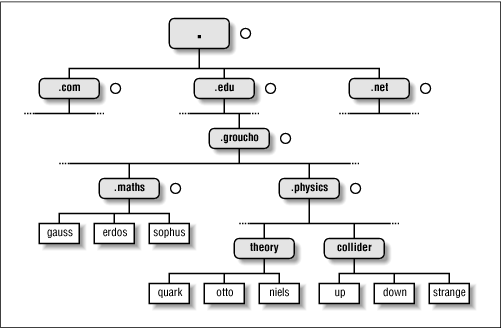How DNS Works
DNS organizes hostnames in a domain hierarchy. A domain is a collection of sites that are related in some sense—because they form a proper network (e.g., all machines on a campus, or all hosts on BITNET), because they all belong to a certain organization (e.g., the U.S. government), or because they’re simply geographically close. For instance, universities are commonly grouped in the edu domain, with each university or college using a separate subdomain, below which their hosts are subsumed. Groucho Marx University have the groucho.edu domain, while the LAN of the Mathematics department is assigned maths.groucho.edu. Hosts on the departmental network would have this domain name tacked onto their hostname, so erdos would be known as erdos.maths.groucho.edu. This is called the fully qualified domain name (FQDN), which uniquely identifies this host worldwide.
Figure 6.1 shows a section of the namespace. The entry at the root of this tree, which is denoted by a single dot, is quite appropriately called the root domain and encompasses all other domains. To indicate that a hostname is a fully qualified domain name, rather than a name relative to some (implicit) local domain, it is sometimes written with a trailing dot. This dot signifies that the name’s last component is the root domain.

Figure 6-1. A part of the domain namespace
Depending on its location in the name ...
Get Linux Network Administrator's Guide, Second Edition now with the O’Reilly learning platform.
O’Reilly members experience books, live events, courses curated by job role, and more from O’Reilly and nearly 200 top publishers.

